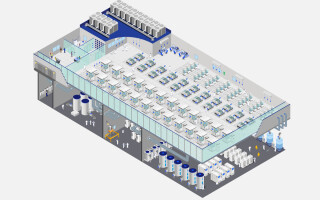Wireless Designs for Smart Cities and Smart Buildings with LP-WAN
January 20, 2022
Story

Analysts predicted that there could be over one billion devices on the low powered wide area networks (LP-WANs) by 2023. This article explains why the RF characteristics of these networks make them so suitable for smart buildings applications such as asset tracking and leak detection, and smart parking applications with sensors. We also offer some advice for device design.
What is LP-WAN?
The LP-WAN are wireless networks using frequencies below 1GHz. Such networks have been used for M2M (machine-to-machine) traffic for many years. They provide the combined benefits of low power, security, long range, and mobile working — so, their popularity grows alongside the expansion of the IoT.
Four technologies dominate the industry: NB-IoT, LTE-M, LoRa-WAN, and SigFox. All of these offer long-range communications with a low bit rate good for small, intermittent data packets of M2M traffic.
LoRa typically uses the frequencies: 433 MHz in Asia, 868 MHz in Europe, and 915Mhz in the US. NB-IoT uses the mobile network operator bands available in each country, typically 700 MHz, 800 MHz, or 900 MHz.
RF at Low Frequencies
Radio wavelengths are longer at low frequencies and shorter at high frequencies. Higher frequencies can carry more data, but their signal loss is greater over longer distances and within buildings where walls and masonry obstruct the transmissions.
Radio waves can travel through diverse atmospheric conditions, most building materials, and heavy foliage. However, at lower frequencies with longer wavelengths, the absorption or loss of signal from obstructions such as walls and building is less than it is at higher frequencies, so the signals can travel further and require less power. This means that LP-WAN at frequencies below 1GHz can cover longer ranges with lower data speeds.
It also means that in more urban areas, the radio signals can pass through buildings and reach underground more easily, while in more rural areas LP-WAN signals will travel greater distances, making it good for smart agriculture (for example, tracking livestock or monitoring soil moisture with sensors). LP-WAN connections are not as fast as broadband, but they deliver useful long range communications with low power requirements and low operating costs.
Why LP-WAN Works for Smart Buildings and Smart Cities
From a technical standpoint, LP-WAN is an attractive choice for low data rate applications. It can operate over fairly long ranges — distances of 2km to 15km can be feasible — and the connections are less expensive than with cellular networks. The data packet sizes can be from 10 to 1,000 bytes, and the uplink speeds can be as fast as 200 Kbps. This allows LP-WAN to support applications with small data packets perfectly, while consuming very little power. This is a big advantage for large fleets of battery powered devices spread across a network.
These features make LP-WAN suitable for tracking vehicles and containers and for connecting networks of sensors to measure location, vibration, temperature, loads, and speeds. In smart cities, all kinds of applications are possible: smart parking applications with sensors in parking spaces to help citizens find spaces that are available; lighting that turns on only when people are in the vicinity; and water services can be monitored for signs of leakage or pollution.
LP-WAN is a good choice for large-scale IoT deployments or networks of sensors where devices only need low power, the data packets are relatively small, and the timing is not too critical.
LP-WAN provides an efficient way to monitor devices remotely if they are difficult to reach by other means, say, when they are located in remote areas or dangerous places. It’s also suitable for connecting smart meters, which are often located in basements or below ground.
Licensed or Unlicensed Networks?
The four leading wireless technologies all use similar frequencies and provide wide coverage with scalability. However, they have different technical and commercial characteristics.
NB-IoT uses very narrow channel frequency bandwidths and offers longer ranges while LTE-M works for mobile devices with shorter transmit distances. LTE-M has a higher data rate and lower latency than NB-IoT and supports devices that are not stationary and travel between base stations. Both NB-IoT and LTE-M require cellular coverage which may not always be available in rural areas.
Additionally, NB-IoT and LTE-M use cellular frequencies that are licensed (there are costs to use them), but they suffer less from interference and the quality of service is higher. Cellular bands provide greater speed and reliability which makes NB-IoT and LTE-M suitable for mission-critical work, such as turning off a gas valve as soon as a leak is detected. They are usually the best fit for metering applications, which may require a QOS.
For applications with small data requirements, SigFox and LoRa may be a better fit. SigFox and LoRaWAN are unregulated, but on these networks, there is nothing to prevent interference.
Both SigFox and LoRa operate in unlicensed bands and can cover great distances with lower power consumption, but at slower data speeds with limits on how often messages can be sent. Additionally, the data payload is usually less than 100 bytes at a time. A solution provider also has the option of using SigFox or LoRa to build their own private network and installing their own gateways.
IoT devices are typically designed to operate in situ for 8-10 years without replacing their batteries, and LP-WAN networks are efficient because the devices on the network are asleep most of the time and only wake up when a message is sent. Device designers should therefore keep the data messages short in order to preserve battery life.
Designing Wireless Devices for LP-WAN
A wireless device is only as good as its antenna. If the antenna should drop its connection, or if its radiation efficiency is compromised in some way, the product ceases to perform as designed. The antenna is the interface between the device and the network, and the efficiency and gain of the antenna are two key factors in determining how far the signal can travel. This means that a more efficient, higher performing antenna placed correctly within the device will enable the device to perform much better on its network in a real-world situation.
An antenna can work perfectly in free space, but behave differently in a real-life environment. Radio waves can suffer from refraction, polarization, diffraction, and absorption. In particular, the metal components and casings of a device can cause reflections, and parts of the human body can cause absorption. This can cause an antenna to de-tune and drain battery power because it has to increase the transmit power of the radio to compensate for the lower antenna performance. For LoRa or Sigfox, the transmitter cannot adjust power levels, so the range is shortened instead.
If there are multiple antennas within one device, there usually is a coupling effect that can absorb the transmit power from the radio. The only way to be certain of correct RF performance is to place each antenna with care to ensure expected performance, and to test the design in an anechoic chamber — first with the antennas in free space and then introducing the use case scenario to ensure the device will perform as expected.

It is important to place the antenna in the design so that it is able to radiate in the most efficient way without forcing the transmitter to operate at maximum power, draining the battery life. This is why antenna experts advise designers to address the integration of the antenna early on in the design process.





